Welcome to MyGardensBloom.com! Today, we’re excited to introduce you to the stunning Agapanthus flower , commonly known as the “Lily of the Nile.” These captivating flowers are beloved by gardeners worldwide for their striking, spherical clusters of trumpet-shaped blooms and their robust, easy-to-grow nature. Whether you’re looking to add a splash of color to your garden borders or seeking an elegant focal point for your containers, Agapanthus is an excellent choice.
Agapanthus belongs to the Amaryllidaceae family and is native to South Africa. Known for its tall, graceful stems topped with umbels of blue, white, or purple flowers, Agapanthus can add a touch of sophistication and vibrancy to any garden setting. The name “Agapanthus” is derived from the Greek words “agape” (love) and “anthos” (flower), which perfectly encapsulates the affection gardeners have for these beautiful blooms.
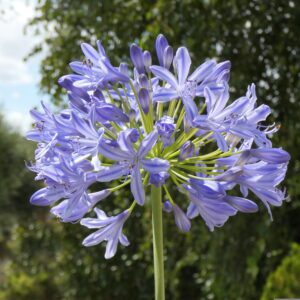
Agapanthus plants typically grow between 2 to 4 feet tall, with some varieties reaching up to 6 feet. The height largely depends on the species and cultivar. The clump-forming habit of Agapanthus allows the plants to spread to about 1 to 2 feet in width. The foliage of Agapanthus consists of long, arching, strap-like leaves that are typically glossy green. The leaves form dense, basal rosettes that provide a lush, green backdrop for the striking flowers.
Agapanthus flowers are borne in large, spherical umbels, each containing numerous individual florets. The flower heads can measure 6 to 8 inches in diameter, creating a bold visual impact. Flower colors range from deep blue and violet to pale blue, lavender, and white. Some cultivars may have bi-colored flowers with contrasting hues. Agapanthus blooms primarily from mid-summer to early fall, with the flowers lasting several weeks.
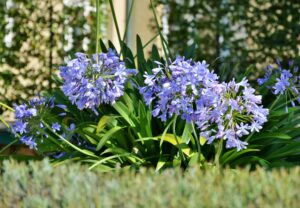
Popular Cultivars of Agapanthus Flowers
Agapanthus boasts a variety of cultivars that bring diverse colors, sizes, and growth habits to gardens. These cultivars have been developed to enhance the natural beauty of the plant, providing gardeners with options that suit different design preferences and garden conditions.
Agapanthus ‘Blue Giant’: True to its name, ‘Blue Giant’ features large, impressive flower heads with deep blue blooms. The flowers are borne on tall, sturdy stems, making a bold statement in any garden.
Agapanthus ‘Albus’: This cultivar is known for its elegant, pure white flowers that provide a striking contrast against the dark green foliage.

Agapanthus ‘Peter Pan’: This dwarf variety is characterized by its compact size and sky-blue flowers. It is an excellent choice for smaller gardens and container planting.
Agapanthus ‘Queen Mum’: ‘Queen Mum’ is a bicolored variety with striking blue and white flowers. The blooms are large and held on tall stems.
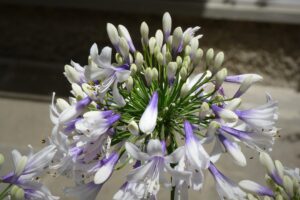
Agapanthus ‘Silver Baby’: This cultivar features delicate white flowers with a hint of blue on the edges. The flowers are smaller and more subtle than other varieties.
Agapanthus ‘Black Pantha’: ‘Black Pantha’ is distinguished by its dark purple, almost black buds that open to deep blue flowers. The blooms are dense and dramatic.
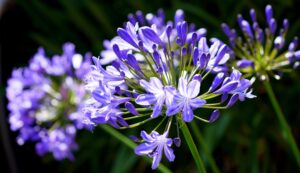
Sunlight Requirement
Agapanthus flowers perform best when they receive full sun, which means at least 6 hours of direct sunlight daily. This promotes robust growth and prolific blooming. While they prefer full sun, Agapanthus can tolerate partial shade, especially in hotter climates. In partial shade, they should still receive at least 3-4 hours of direct sunlight, preferably in the morning, with some afternoon shade to protect from intense heat.
Temperature and Humidity Requirement of Agapanthus Flower
Agapanthus prefers moderate temperatures, thriving best in the range of 60-75°F (15-24°C). They can tolerate higher temperatures up to 90°F (32°C), especially if provided with adequate water and some afternoon shade in extremely hot climates. Agapanthus is not frost-hardy and can suffer damage in temperatures below 40°F (4°C). In regions with cold winters, they should be grown in pots that can be moved indoors or provided with frost protection.
Agapanthus can survive outdoors year-round in USDA hardiness zones 8-11. In colder zones, they should be dug up and stored indoors or treated as annuals.
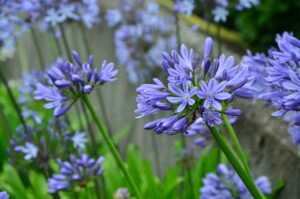
Soil Requirements
The most crucial requirement for Agapanthus is well-draining soil. This helps prevent root rot, which they are susceptible to if the soil remains waterlogged. Agapanthus can grow in a variety of soil types, including sandy, loamy, and clay soils, as long as they have good drainage. They prefer slightly acidic to neutral soil, with an ideal pH range of 6.0 to 7.0. However, they are quite adaptable and can tolerate a range of pH levels from 5.5 to 7.5.
If growing Agapanthus in containers, use a high-quality potting mix that includes perlite or sand to ensure good drainage.
Propagation of Agapanthus Flower
Agapanthus is generally propagated through root division rather than corm division, as they do not form corms like some other bulbous plants (e.g., crocuses or gladioli). However, dividing the root clumps is a similar process to corm division in principle. Here’s a detailed guide on how to propagate Agapanthus through root division:

Root Division
The ideal times for dividing Agapanthus are early spring or early autumn. This allows the plants to establish roots before the stress of extreme weather.
Water the plant thoroughly the day before you plan to divide it.
Carefully dig up the entire clump of Agapanthus. Use a spade or garden fork to lift the plant from the ground, being careful not to damage the roots. Dig around the plant at a distance to avoid cutting through the roots.
Shake off excess soil from the roots. You can also rinse the roots with water to get a clear view of the root structure.
Look for natural divisions in the clump. Each division should have several shoots or leaves and a healthy portion of roots.
Use a sharp, clean knife or garden spade to cut the clump into smaller sections. Ensure that each section has a healthy amount of roots and at least a few leaves or shoots. Some larger clumps may come apart naturally with gentle pulling.
Prepare planting holes in well-draining soil. Each hole should be wide and deep enough to accommodate the root section without crowding.
Replant each division at the same depth it was growing before. Space the plants about 18-24 inches apart to allow for growth.
Fill the holes with soil, firming it gently around the roots to eliminate air pockets.
Water thoroughly after planting to help settle the soil and establish the roots.
Keep the soil consistently moist until the new plants establish themselves, which usually takes a few weeks.
Divided plants may take a season to settle in and flower, but they should bloom vigorously once established.
By following these steps, you can successfully propagate Agapanthus through root division, ensuring a healthy and thriving addition to your garden.
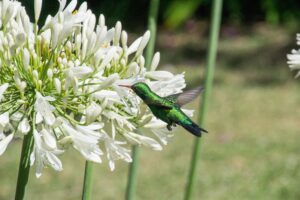
Watering Requirements
When first planted, Agapanthus should be watered thoroughly to help establish their root systems. This involves soaking the soil around the plants to ensure that the water reaches the root zone. Once established, Agapanthus prefers moderate watering. Water the plants deeply once a week during the growing season (spring through fall). In hot or dry climates, you may need to increase the frequency to twice a week. Ensure that the soil remains consistently moist but not waterlogged. The top inch of soil should dry out between waterings, but the soil below should remain slightly moist.
Agapanthus grown in containers will dry out more quickly than those planted in the ground. Check the soil moisture regularly and water when the top inch of soil feels dry. Ensure the containers have drainage holes to prevent waterlogging.
Fertilizer Requirement of Agapanthus Flower
Proper fertilization is essential for Agapanthus, or African lily, to ensure robust growth and abundant flowering. Use a balanced, slow-release fertilizer with an equal ratio of nitrogen (N), phosphorus (P), and potassium (K), such as 10-10-10 or 14-14-14. This provides a steady supply of nutrients over time. To promote blooming, you can also use a fertilizer higher in phosphorus, like a 5-10-10 formula, which supports flower development.
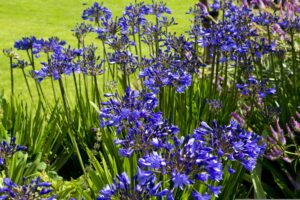
Fertilize Agapanthus flower in early spring as new growth begins. This gives the plants the nutrients they need to support new foliage and flower production. Apply a second dose of fertilizer in mid-summer to encourage continued blooming and maintain plant health.
Container-grown Agapanthus may require more frequent fertilization, as nutrients leach out more quickly from pots. Use a diluted liquid fertilizer every 4-6 weeks during the growing season.
Problems While Growing Agapanthus Flower
Growing Agapanthus, or African lily, can be quite rewarding, but like any plant, it can face several problems. Here are some common issues and how to address them:
Pests
Aphids: These small, sap-sucking insects can cause yellowing leaves and stunted growth. Treat with insecticidal soap or neem oil.
Snails and Slugs: These pests can chew holes in leaves and stems. Use slug pellets, traps, or barriers like crushed eggshells around the base of the plants.
Mealybugs: These pests appear as white, cottony masses on leaves and stems. Remove them manually and treat with insecticidal soap or alcohol-soaked cotton swabs.
Diseases
Root Rot: Caused by overly wet soil and poor drainage. Ensure well-draining soil and avoid overwatering. If root rot occurs, remove affected plants and improve soil conditions.
Gray Mold (Botrytis): Appears as fuzzy gray spores on leaves, stems, and flowers, especially in damp conditions. Improve air circulation, avoid overhead watering, and remove affected parts.
Leaf Spot: Fungal or bacterial spots on leaves can be controlled by removing affected leaves and applying a fungicide if necessary. Ensure good air circulation and avoid water splashing on leaves.
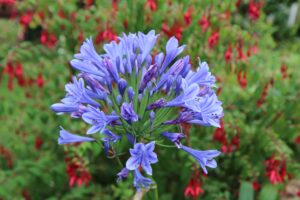
Other Problems
Yellowing Leaves: This can indicate a nitrogen deficiency. Apply a balanced fertilizer or compost to improve nutrient levels.
Poor Flowering: Insufficient phosphorus can lead to fewer blooms. Use a fertilizer higher in phosphorus (e.g., 5-10-10) to encourage flowering.
Frost Damage: Agapanthus is not frost-hardy and can suffer in freezing temperatures. In colder climates, protect plants with mulch or move container plants indoors during winter.
Overcrowding: Agapanthus can become overcrowded, leading to reduced flowering and increased disease susceptibility. Divide clumps every 3-4 years to maintain vigor.
Improper Planting Depth: Planting too deep can cause poor growth and flowering. Ensure the crown of the plant is at soil level.


